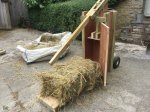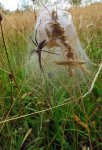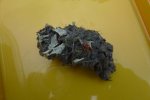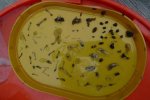Not really bushcraft but I’ve been having a go at scything recently and wanted to make some hay - I figured that if nothing else, doing something that required a few days of sunny dry weather would bring the current drought to an end!
My local scything guru helps run Caring for God's Acre a non religious group which helps maintain churchyards as Wildlife havens using traditional tools. Through them I got some plans for a hand baler apparently used in the US to bale “pine straw” - pine needles used as garden mulch.
http://www.caringforgodsacre.org.uk/images/uploads/fact_sheets/Hand Hay Baler Plans.pdf
There are a few gaps in the plans but after a bit of trial and error and a fair bit of 4x2 and 3x2, I now have a functioning baler. A bit of fettling still required but quite pleased with the first bale - about 2/3rds the size of a conventional small bale,

As a first effort, I was a bit wary of putting too much pressure on the lever and although the bale is pretty solid, it should be possible to compress a fair bit more hay into future bales and with a bit more care loading the hay, it should be possible to make pretty decent (if not quite machine standard) bales reasonably quickly.
Maybe not strictly traditional but a lot easier to store and manage than loose hay and every other part of the process, is done using traditional tools; scythe, pitch fork and hay rake.
My local scything guru helps run Caring for God's Acre a non religious group which helps maintain churchyards as Wildlife havens using traditional tools. Through them I got some plans for a hand baler apparently used in the US to bale “pine straw” - pine needles used as garden mulch.
http://www.caringforgodsacre.org.uk/images/uploads/fact_sheets/Hand Hay Baler Plans.pdf
There are a few gaps in the plans but after a bit of trial and error and a fair bit of 4x2 and 3x2, I now have a functioning baler. A bit of fettling still required but quite pleased with the first bale - about 2/3rds the size of a conventional small bale,

As a first effort, I was a bit wary of putting too much pressure on the lever and although the bale is pretty solid, it should be possible to compress a fair bit more hay into future bales and with a bit more care loading the hay, it should be possible to make pretty decent (if not quite machine standard) bales reasonably quickly.
Maybe not strictly traditional but a lot easier to store and manage than loose hay and every other part of the process, is done using traditional tools; scythe, pitch fork and hay rake.
Last edited:



